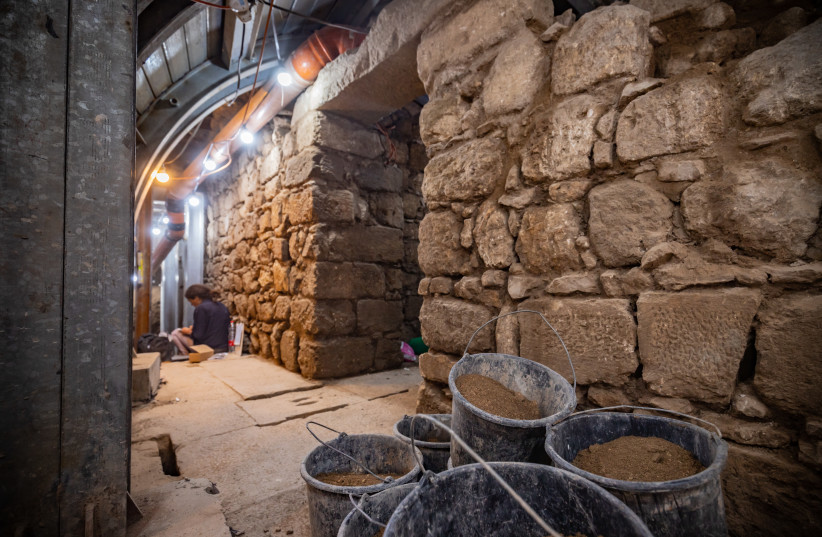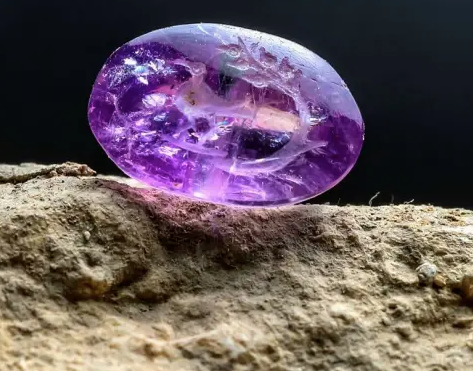The small lilac stone, featuring the engraving of a bird and a branch with five fruits, had fallen into the main drainage channel of Jerusalem from the Second Temple period.
In the last decades before the destruction of the Second Temple, someone – a Jew, possibly a pilgrim – walked on the imposing road that connected the Shiloah Pool at the outskirts of Jerusalem with the Temple Mount.
For the important occasion, he wore his most precious clothes and ornaments, including a delicate ring bearing an engraved lilac amethyst stone. But in the crowd, the ring broke, the stone slipped on the floor and then into the underground drainage channel.
Some 2,000 years later, the tiny artifact was retrieved by volunteers sifting through soil dug during an archaeological excavation in the area.
After examining it, the experts found an additional surprise: The iridescent stone probably features the first-ever known depiction of a plant prominently mentioned in the Bible, as well as in later Jewish and historical sources, as the City of David, the Antiquities Authority and the Israel Nature and Parks Authority (INPA) said Thursday in a joint statement.
Known as “balm of Gilead” (tzori in Hebrew), balsam tree (nataf) or “persimmon” later in the Mishnaic period, the plant, whose modern scientific name is commiphora gileadensis, was used to produce perfumes, incense and medicines.

The elongated branch bearing five fruits engraved on the stone caught the experts’ attention because it appeared to be something different from any other species ever found portrayed on seals from the time.
“Toward the end of the Second Temple period, the use of stone stamps expanded and became more common,” said Prof. Shua Amorai-Stark, an expert in engraved gems. “But in most stamps discovered so far with plant engravings, it is common to find plants that were common in Israel at the time: vines, dates and olives, which are among the seven species. But on this stone seal, we immediately noticed that the fruit that appears on it is unlike any of the fruits we have encountered to date.”
In Genesis, when Jacob’s sons sit for their meal after throwing their brother Joseph into a pit, they decide to sell him into slavery after seeing “a caravan of Ishmaelites coming from Gilead, their camels bearing gum, balm and ladanum to be taken to Egypt.”
“The Eternal said to Moses: ‘They shall bring to you fragrant spices, sap of a balsam tree, onycha, galbanum, and other fragrant spices with pure frankincense. Each of them shall be of the same weight, and make of it incense, a perfume after the art of the perfumer, mixed together, pure and holy,” read two verses in the 30th chapter.
The balm of Gilead was also known to be a component of the favorite perfume of Cleopatra, the legendary queen of Egypt.
“This is an important find because it may be the first time a seal has been discovered in the entire world with an engraving of the precious and famous plant, which until now we could only read about in historical descriptions,” said archaeologist Eli Shukron, who conducted the excavation at the foundations of the Western Wall on behalf of the IAA and the City of David.
The seal was found by participants in the “Archaeological Experience” project, supported by the City of David and the INPA, at Emek Tzurim National Park.
The oval stone, approximately 10 mm. long and five mm. wide, also features a bird, probably a dove.
Both the tree and the dove embodied good fortune and success, the experts said.
“The balsam plant is a positive symbol because, beyond the fact that it was used to produce perfumes and medicines, the ancient persimmon – which, by the way, is not at all similar to today’s persimmon – was attributed magical and ceremonial properties and is one of the ingredients used for making the Temple incense during the Second Temple period, which is when this seal was made,” Shukron said.
“The dove is also a positive motif in the Hellenistic, Roman and Jewish world,” Amorai-Stark said. “It symbolizes wealth, happiness, goodness and success.”
The owner of the ring was likely a wealthy person, he added.
“The production and trade that took place around the persimmon plant were tightly controlled at the time by Jews living in the Dead Sea basin, where the fruit was grown,” Amorai-Stark said. “I guess the owner of the seal was a man who owned a persimmon orchard, and when he came to the craftsman who made the ring for him, it is possible he may have brought a branch of persimmon so that the craftsman knew what to carve on the stone.”
Subcribe to The Jewish Link Eblast






